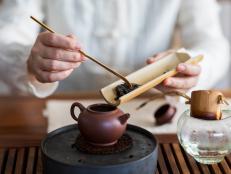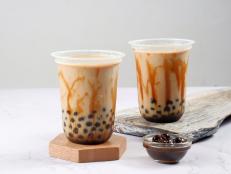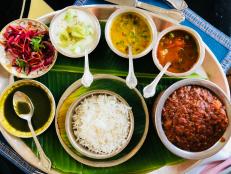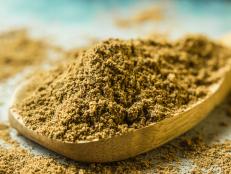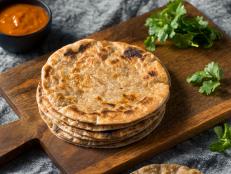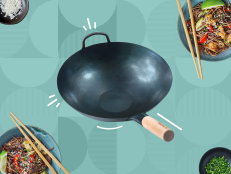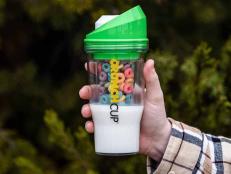A Deep Dive Into Chai: Its History, Its Health Benefits and How to Prepare It
According to the founder of a small batch chai company.

undefined undefined/Getty Images
By Layla Khoury-Hanold for Food Network Kitchen
Layla Khoury-Hanold is a contributor at Food Network.
Chai has a ubiquitous presence on coffee shop menus in the U.S., but it’s a beverage with deep roots in Indian and South Asian culture. To bring you more info, we chatted with Farah Jesani, the founder of One Stripe Chai, a small batch chai company that produces blends and concentrates using high-quality, ethically sourced ingredients.
What Is Chai?
Chai is a sweet and spicy beverage made with black tea, a combination of spices and sweetener, boiled with milk and water. Chai is the word for tea in Hindi, but contrary to popular belief, chai is not an ancient Indian drink.
The History of Chai
Prior to the 1800’s, tea wasn’t commercially grown in India. “During the British rule of India, it was noted that tea grew wild in Assam, and therefore the land was conducive to growing this plant. The British brought commercial tea cultivation and production to India to create a cheaper source for tea, which was becoming increasingly popular in Britain and increasingly expensive because China held a monopoly on it,” Jesani says. “Britain soon began marketing tea to Indians in the form of tea breaks for factory workers and funding for independent chai wallahs along railroad lines. Much to their dismay, as Indians began drinking tea, they tended to add spices and much more milk, reducing the amount of tea used.”
The Culture of Chai
Chai is much more than a beverage. “Chai is a way of life in South Asian culture. It’s a constant presence in our lives, a daily ritual of sorts—sometimes it’s consumed multiple times a day,” Jesani says. “Chai is also very communal. It brings people together, whether it’s the whole family catching up over chai and snacks in the evening or at gatherings and dinner parties or even weddings or Friday prayers.”
One of the reasons Jesani started One Stripe Chai is because of how important chai is to her family and her Indian immigrant parents. “I grew up with chai all around me in my daily life. It was made in my parents’ home twice a day as far as I can remember,” she says. “In addition to that, chai was served in the outdoor courtyard every Friday after mosque, and the drink became the centerpiece of all the socializing in our South Asian communities. I can’t remember ever going to a family member or family friend’s home and not being offered chai!”
Chai Misconceptions
“Chai is the word for tea in Hindi. In fact, when people mistakenly say, ‘chai tea’ they’re actually saying, ‘tea tea,’” Jesani says. “So, when ordering, it’s enough to just say ‘chai.’”

Seemanta Dutta/Getty Images
What Is In Chai?
Chai is a sweet, spicy, creamy beverage made with black tea, a blend of spices, water, milk and sweetener. Jesani says that chai is typically made using a type of black tea called CTC, which reflects how the leaves are processed: “CTC (cut, tear, curl) is a method of processing black tea in which large rollers crush, tear, and curl the tea leaves into small granules. CTC black tea is robust and malty and perfect for boiling up with milk and spices,” she says.
“Even though chai as a beverage is pretty ubiquitous in the larger Indian subcontinent and beyond, part of what makes chai so special is that there is no single, standard way to prepare it,” Jesani says. “Every family has their own unique recipe for chai, so even though the base flavor of chai is similar, the taste depends not just on what spices go into it, but also who is making it. Chai can taste different and even be brewed differently from family to family and region to region.”
- Masala Chai: “Masala chai is one of the most well-known flavor profiles—masala means spice and chai means tea, so masala chai means ‘tea with spices.’ It’s typically made with black tea; a variety of spices, such as cinnamon, cardamom pods, ginger, cloves and star anise; sweetener, such as jaggery (unrefined cane sugar) or honey; milk (most often whole milk); and water.
- Other Chai Varieties: “There’s a pink-hued Kashmiri chai, there are regional varieties, and even within those there are family recipes that get passed down to younger generations,” Jesani says. “It’s a deeply personal drink, but one that also binds an entire culture together.” One Stripe Chai offers different blends that incorporate flavors, herbs and spices such as rose, mint, lemongrass, and mango.
Does Chai Have Caffeine?
Jesani notes that all tea is derived from the camelia sinensis plant; the method for processing the leaves determines whether it becomes black tea, green tea or hōjicha, which in turn affects caffeine content. “Chai is typically made using a type of black tea called CTC (crush, tear, curl), where the leaves are processed through a cylinder with sharp teeth that crush the leaves up into hardened pellets, compared to regular tea, where the leaves are rolled into strips.”
Generally, black tea’s caffeine levels range from 50 to 90 milligrams of caffeine per cup (versus 80 to 100 milligrams of caffeine per cup of coffee). Jesani points out that there are several factors that can impact caffeine levels for each batch of chai, such as water temperature, steeping time and the tea-to-milk ratio. The ‘does chai have caffeine’ question has come up often at One Stripe Chai. Earlier this year, Jesani released a special low caffeine version of chai called Chai After Five. It features hōjicha, a roasted green tea that uses the twigs and stems of the green tea plant and is naturally lower in caffeine.
Chai Benefits
The benefits of drinking chai typically come from the combination of spices used in the blend. “For example, cardamom is said to be good for digestion with great antioxidant properties, while black pepper said to be supportive in battling inflammation,” Jesani says. “A great non-health benefit of chai is that the ritual of brewing chai can be calming and allow you space to set intentions for the day while you go through the steps of brewing.”

galitskaya/Getty Images
How to Make Chai
Making your own chai blend at home is easy, especially if you buy your spices in bulk and use them right away so they don't lose flavor. But if you’d prefer to use a pre-made blend, check out our guide to the Best Chai Blends.
“This is my go-to masala chai recipe when I am craving a creamy chai that has warm flavors. I like to use an equal amount of water to milk ratio because I like a creamier chai, but feel free to adjust your ratios and spice combinations and amounts according to your preference. I use raw brown sugar for this recipe, but other sweetener options include jaggery, honey and maple syrup," Jesani says.
Ingredients for 1 Cup of Chai
- 4 cardamom pods
-
2 cloves
-
3 black peppercorns
-
1 teaspoon grated fresh ginger
-
2 teaspoons CTC black tea
-
1 cup milk of choice
Tools to Make Chai
- Measuring spoons and cups
- Mortar and pestle
- Small pot
- Chai Strainer
How to Make Chai, Step-By-Step
- Prepare the Spice Blend: Measure out your spices and use a mortar and pestle to crush your whole spices into very small pieces. You can also use a spice grinder.
- Brew the Spices and Tea: Add 1 cup of water and the crushed spices to a small pot on the stove and bring to a boil. Add the CTC black tea. Lower the heat to medium-low and simmer until the water is a beautiful amber color from the tea releasing its flavor, 2 to 3 minutes.
- Add Milk and Boil: Add the whole milk (or dairy-free alternative) and bring the mixture to a boil. The liquid and bubbles will rise as they start to boil, so pay close attention to ensure that the pot doesn’t boil over. If the chai is about to boil over, remove it from the heat or quickly lower the heat. To really infuse flavor into the liquid, bring the mixture to a boil two times.
- Simmer the Chai: Simmer chai for 3 to 4 minutes to release more flavor and evaporate some of the liquid.
- Strain and Serve: Use a chai strainer (or a fine mesh sieve or cheesecloth) to strain the chai into your favorite mug or kulhad, an unglazed clay vessel that is often used for serving chai in South Asian households. Enjoy piping hot!
Tips for Making Chai
- Use the Right Kind of Tea: “The most common mistake people make when making masala chai is using the wrong tea! If you want a drink that is bold and full of spice, you’ll need to use a specific type of black tea that can stand up to being boiled and stand up to the addition of spices and milk. In comes CTC black tea,” Jesani says. “The leaves are processed through a cylinder with sharp teeth that crush the leaves up into hardened pellets, whereas with regular tea, the leaves are rolled into strips.”
- Use fresh Spices: Buy dry spices from a bulk store with a high turnover to ensure that you’re using the freshest and most flavorful spices available. Use spices right away and replenish as needed.
- Grind Your Spices: Use a spice grinder or mortar and pestle to grind your spices before brewing to ensure that you release the spices’ aromatic oils to impart maximum flavor into your chai.
- Use a Stainless-Steel Pot: You can use any saucepan or pot to make chai, although Jesani recommends using stainless steel pots rather than cast iron, enamel or nonstick, as regular boiling of spices and teas can damage the finish on those types of pans. In South Asian homes and communities, many families use a pot that has a slight spout on it to help pour the strained chai into a cup.
- Simmer Longer for Stronger Flavor: Jesani notes that the longer you simmer the chai, the stronger the flavors extracted from the tea and spices will be.
How to Store Chai
Dry chai blends should be stored in a cool, dry place. They will keep fresh for several months, even up to a year. “Because we hand pack our chai blends using high quality, ethically sourced ingredients, with spices being at their very peak, over time the potency of those flavors may decrease—the same way the spices in your pantry are most powerful when they’re fresh,” Jesani explains. “Chai blends don’t “expire,” but the chai may not be as strong as you like after a year or so.”
Jesani says that brewed chai is best enjoyed piping hot, but that iced chai makes a great alternative on hotter days. Leftover chai can be cooled and stored in the refrigerator in an airtight container for up to 2 days.
Related Links:






















